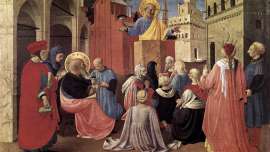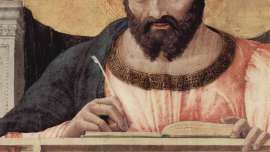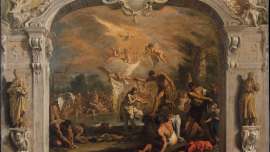Lesson Goals
- To understand the characteristics and identity of the kingdom of God as it is portrayed in the New Testament epistles and the Book of Revelation.
- To see how the Church is identified with the kingdom in the New Testament.
- To understand how the Church, as it is portrayed in the New Testament, bears the characteristics of the Davidic kingdom.
Lesson Outline
I. Kingdom and Church
A. Review and Overview
In our first five lessons, we’ve explored in a detailed way the Old Testament’s understanding of the kingdom of God and its significance to the overall narrative unity and meaning of the Bible.
We’ve also undertaken a close examination of the gospels of Matthew and Luke, as well as the Book of Acts, in order to consider how the kingdom was understood in the preaching of Jesus and in the proclamation of the apostolic Church.
In this final lesson, we want to look at the kingdom theme as found in the remainder of the New Testament writings.
It’s true that outside of the synoptic gospels and Acts, explicit references to the kingdom of God are sparse. However, it is clear that these New Testament writings share the same presumption that the kingdom proclaimed by Christ is the restoration of the everlasting kingdom promised by God to the son of David (see 2 Samuel 7).
Throughout the New Testament, Jesus himself is designated as the messianic offspring promised to David (see Romans 1:3; Revelation 5:5, 22:16; Sirach 47:2). Hebrews applies a messianic psalm to Christ, identifying Him as David’s anointed son whose kingdom will last forever (see Hebrews 1:8-9; Psalm 45:6-7).
Christ’s resurrection and ascension are described as a heavenly enthronement at God’s right hand. In this, Christ is shown to fulfill the messianic promise of Psalm 110:1 (seeEphesians 1:20; Hebrews 1:13).
He is depicted as ruling from heaven over a restored Davidic kingdom – a kingdom that embraces both Jews and Gentiles (see Ephesians 3:6; 2:18-19).
Christ is said to have dominion and authority over both “those in heaven and on earth” (seePhilippians 2:9-11; Revelation 5:10; 2 Timothy 4:18). Furthermore, his rule is for all ages – “not only in this age but also in the age to come” (see Ephesians 1:20-21; Revelation 1:5; 2 Peter 1:11).
B. The Beloved Son
The core of Christ’s gospel – the proclamation of the kingdom – underlies the New Testament writings, even if the term “kingdom” itself is only infrequently used. And in these writings, we’re given a richer and fuller understanding of the identity and characteristics of the kingdom.
The kingdom is closely associated and, in a certain way, identified with the Church.
Colossians, for instance, uses language that hearkens back to the exodus to describe the salvation that comes in the Church: “He delivered us from the power of darkness andtransferred us to the kingdom of His beloved Son, in whom we have redemption” (seeColossians 1:13).
This passage introduces Colossians’ great hymn to the beloved Son, who is described as “the head of . . . the Church” (see Colossians 1:18).
Thus, the kingdom of the beloved Son and the Church seem to be very nearly identical in the mind of Paul.
In Ephesians, too, it seems that the terms “Church” and “kingdom” are used almost interchangeably. Jesus is called the head of the Church (see Ephesians 1:22; 5:23) and His dominion is described as “the kingdom of Christ and of God” (see Ephesians 5:5).
II. The Covenants of Promise
A. The First-Born
We find a further association of kingdom and Church in the family imagery used to describe the New Testament community. This imagery shows the early Church seeing deep ties between the covenants of Israel’s salvation history and the sacraments of the Church.
Jesus is described frequently as God’s “first born” (see Luke 2:7; Romans 8:29; Colossians 1:15,18) – a designation that evokes a key theme in God’s relationship with Israel.
God named Israel His first-born son among the nations (see Exodus 4:22; Deuteronomy 32:6; Hosea 11:1; Sirach 36:11).
This “primogeniture” was closely related to Israel’s covenant mission as a “kingdom of priests” (see Exodus 19:6) – to be mediators of the knowledge and true worship of the living God to its “brother” nations.
In His covenant with David, God deepened this identification of Israel’s first-born and priestly stature and its mission to reign over all nations – swearing that David’s son would be His son, “the first-born, the highest of the kings of the earth,” and a “priest forever” (see2 Samuel 7:12-14; Psalm 2:7; 89:27-29; 110:4; John 7:42).
In the New Testament, these promises are directly applied to Jesus (see Hebrews 1:5-6;7:21; Revelation 1:5). Jesus, through His death and resurrection, becomes “the firstborn” of “many children” (see Romans 8:29; Hebrews 2:10-13).
The kingdom is frequently described in the New Testament epistles as an “inheritance” (see Ephesians 5:5; 1 Corinthians 6:9-10; 15:20; Galatians 5:21; Colossians 1:12). This inheritance is claimed through faith in the gospel, a faith that finds expression in the sacrament of baptism.
In the only use of “kingdom” language in John’s gospel, Jesus tells Nicodemus that entry into the kingdom of God means being begotten by water and the Spirit (see John 3:3,5).
Baptism is how one enters the kingdom and how one enters the Church. Again we see a presumption of the near identity of Church and kingdom.
Through baptism, believers come to share in the national history of Israel, which is also the history of salvation. They become “sharers in the covenants of promise” that God made to Israel (see Ephesians 2:12).
In particular, they become heirs to the family of God, according to the promise made to Abraham – that through Abraham’s descendants all the nations of the world would be blessed (see Romans 8:17; Galatians 3:29)
As we looked at in detail in our first lesson, all of Israel’s history, including the exodus from Egypt, the covenant made at Sinai, and the establishment of the monarchy under David, can be seen as partial fulfillments of God’s covenant with Abraham.
The ultimate fulfillment of that covenant comes in the blood of Jesus, by which believers are made “children of Abraham” (see Galatians 3:7-9) and “children of God” through the working of the Holy Spirit (see Galatians 3:26; 4:6-7).
The kingdom, then, is understood in a certain sense as a family of God, in which believers are called to conduct themselves worthily as God’s children (see 1 Thessalonians 2:12).
B. Kingdom of Priests
Here again, we see a tight connection between the early Christian notions of Church and kingdom. The Church, made up of royal sons and daughters of God, Jewish and Gentile, is the new, and true Israel of God (see Galatians 6:16).
In this, the Church fulfills the original commission and identity given to Israel in the covenant at Sinai. There, God established Israel as a “kingdom of priests, a holy nation” (see Exodus 19:6).
The New Testament writings apply this description of Israel as a priestly kingdom to the Church (see 1 Peter 2:5-10), in which members share in the priesthood and sonship of Christ (see Revelation 1:5-6).
In Revelation’s vision of the scroll and the lamb, Christ is celebrated as purchasing with His blood “a kingdom and priests for our God, and they will reign on earth” (see Revelation 5:10).
Significantly, this kingdom is made up of people, not only from Israel, but from “every tribe and tongue, people and nation” (see Revelation 5:9).
The vision itself is filled with images from the exodus and from Daniel’s vision of the son of man. As Daniel’s son of man receives authority over peoples and nations of every tongue or language, so does the kingdom of priests, the Church, in Revelation (compare Daniel 7:14; Revelation 5:9).
As the son of man receives glory and honor in Daniel’s vision, so does the Lamb in Revelation (compare Daniel 7:13-14; Revelation 5:12). And as the holy ones of the Most High possessed the kingdom in Daniel, the kingdom of priests in Revelation is said to reign on earth (compare Daniel 7:22).
Daniel’s vision evoked the original calling and purpose of Israel. And so does John’s vision of the Lamb.
In this vision we have a summary of the New Testament understanding: The Church – the restored kingdom of David that encompasses the twelve tribes of Israel and all the Gentile nations – fulfills the prophecy of Daniel and is the heir and successor to the promises of Israel.
III. The Key of David
A. The Light to the Nations
The Church is the fulfillment of the kingdom promised to Israel. This is again stressed in Revelation’s final pages.
John sees a vision of the new Jerusalem, the new capital of the new kingdom. The city gates are inscribed with the names of the twelve tribes of Israel, and the foundation stones are inscribed with the names of the twelve apostles (see Revelation 21:9-13).
The depiction of the kingdom as a temple is similar to the depiction of the Church as a spiritual temple (see 1 Peter 2:5).
Israel was commissioned to be a light to the nations (see Isaiah 42:6; 49:6). The new Israel, the kingdom of the Church, fulfills that commission. As John sees it, the new Jerusalem is illuminated by the glory of God and enlightens the entire world, its light brighter than the sun and the moon. “The nations will walk by its light” and kings of the earth stream toward the light, bringing the wealth of nations to pay tribute (see Revelation 21:22-27).
John here is evoking the prophecies of Isaiah concerning the new exodus and the restoration of the Davidic kingdom. Isaiah had prophecied that God would one day be an “everlasting light” brighter than the sun and moon (see Isaiah 60:19) and that nations would come to the light bearing their wealth (see Isaiah 60:3,5).
Isaiah foretold that the gates of the kingdom would be open to people of all nations – a promise that John likewise sees delivered in the kingdom of the Church (compare Isaiah 60:11; Revelation 21:25-26).
Isaiah also foretold that authority (“the key”) over the Davidic kingdom would be turned over to a new royal minister (see Isaiah 22:22).
Christ applied this prophecy to the apostle Peter, and interpreted the “keys to the kingdom” to mean authority in what He called “my Church” (see Matthew 16:18-19).
We see the same identification of kingdom and Church in Revelation, which also offers an interpretation of Isaiah’s prophecy concerning the keys. Jesus is described as the “offspring of David” (see Revelation 22:16) and as “the holy one . . . who holds the key of David” (seeRevelation 3:7).
B. The Davidic Kingdom Restored
We are now in the position to see how the Church, as it is portrayed in the New Testament, bears the characteristics of the Davidic kingdom, as we identified them in Lesson One.
- First, the kingdom of the Church is founded on a divine covenant (see 1 Corinthians 11:25).
- The “king” is the son of David, and the Son of God (see Romans 1:3-4).
- The king is God’s “anointed” (see 1 John 2:20).
- The reign of God’s anointed king is to be eternal (see 1 Timothy 6:16).
- At the center of the kingdom is the spiritual Jerusalem or Zion (see Galatians 4:26).
- Worship in the kingdom is centered on the temple of Christ’s body, which replaces the temple of Jerusalem (see John 2:19-21; Revelation 21:22).
- The kingdom is international, drawing worshippers from Israel and from all the nations (see Revelation 7:1-12).
- Through the kingdom, the nations of the earth are instructed in the divine wisdom of the son of David (see Ephesians 3:10; Colossians 1:28; James 3:17).
- The kingdom is administered by a royal steward (see John 21:15-19) and various officers (see 1 Timothy 3:3-13), and includes a prominent role for the Queen Mother (see Revelation 12:1-6).
- Finally, the worship of the kingdom consists in the offering of sacrifice, especially the sacrifice of thanksgiving, the Eucharist (see Romans 12:1; 1 Peter 2:5).
C. The Kingdom Come
The kingdom is a present reality for the New Testament writers. It is something that has come into the world with Christ (see Revelation 11:15; 12:10). It is an experience and relationship that that believers “share” in (see Revelation 1:9).
But the kingdom is at the same time something of a work in progress. Paul says that he is working for the kingom of God (see Colossians 4:11). And he foresees a final day – “the end” – when Christ will “hand over the kingdom to His God and Father” (see 1 Corinthians 15:24-50).
At that time, Paul says, Christ will have destroyed every sovereignty, authority, and power, and will have conquered the final enemy, death itself.
Revelation also looks forward to a day when “the mysterious plan of God shall be fulfilled” (seeRevelation 10:7). On this day, the kingdom of the world will belong to God and His anointed, a clear reference to Old Testament hopes for a messianic kingdom (see Revelation 11:15; 12:10; Daniel 2;Psalm 2).
Until that day, the New Testament sees the life of the kingdom, the life of the Church, as one of liturgy and anticipation – of worshipping God with a “sacrifice of praise” in union with Christ, who, through His blood consecrates believers as priests of His new covenant (see Hebrews 13:13-15).
We see this most clearly at the conclusion of Hebrews (see Hebrews 12:18-29), which characterizes the kingdom as both already come and not yet completely here. Believers “are receiving” the kingdom as a divine gift. It is something they now possess, but not yet fully.
This is a passage that is remarkable for the wealth of Old Testament imagery that it brings together. It seems to describe, in evocative and symbolic terms, the celebration of the Eucharist.
Believers are described coming to a heavenly Jerusalem to celebrate in a “festal gathering” as an “assembly of the first-born” (see vs. 22-23; compare Hebrews 2:12). The word translated “assembly” is the Greek word ekklesia, the word for “church.” The word translated “festal gathering” means religious or liturgical worship (see Isaiah 66:10)
So, we have the Church on earth worshipping in the new Jerusalem, along with the angels and Jesus, the firstborn from the dead and “the mediator of a new covenant.” The worship of this Church is a sacrifice of thanksgiving (see Hebrews 12:28) for the “unshakeable kingdom” that believers are in the process of “receiving” (v. 27).
IV. Study Questions
- What does the kingdom of God mean in the preaching of Jesus and in the proclamation of the early Church?
- What does it mean to say that Jesus is “the son of David”?
- How does the Church fulfill the covenant mission given to Israel?
- How does the Church, as it is portrayed in the New Testament, bears the characteristics of the Davidic kingdom?


